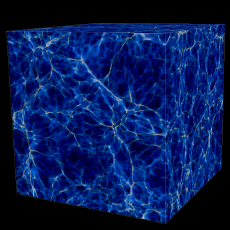Welcome to the THERMAL Suite Home Page!
Most of the cosmic matter in the Universe resides in the space between galaxies, the Intergalactic Medium (IGM), as a very diffuse component. By studying it we can not only understand the the distribution of matter in the Universe but because its ionization and thermal state is governed by the ultraviolet radiation of galaxies and quasars we can also learn about the formation and evolution of these systems.
Because the majority of this gas is diffuse (i.e. at very low densities) it is particularly challenging to study it in emission. Therefore, most of our understanding of the Intergalactic Medium comes from the detection of gas through absorption line spectroscopy. The properties of these absorption lines can provide very interesting information about the IGM, for example what is its thermal state (e.g. what is its temperature). To do this the real observations have to be compared against mocked ones generated from different models. This is a computational challenge, as the full parameter space should be explored and to generate one accurate prediction one expensive hydrodynamical simulation needs to be run. The THERMAL Suite (Thermal History and Evolution in Reionization Models of Absorption Lines) has been built to tackle this challenge and consists on more than 75 cosmological hydrodynamical simulations built to study the thermal state and evolution of the Intergalactic Medium from ~1 Gigayear after the Big Bang until today.
The THERMAL Suite is one of the largest grids of cosmological hydrodynamical simulations ever. All simulations were performed with the public code Nyx. The bulk of the simulations in the THERMAL Suite explore different thermal histories of the Universe. However a subset of simulations have been run to quantify possible systematics.
If you want to learn more, please see our about page. The THERMAL Suite is a public database to the scientific community. You can already directly download part of this dataset and some post-processed products for your scientific work. We are also happy to provide access to any data upon request, so if you are interested please contact us.
